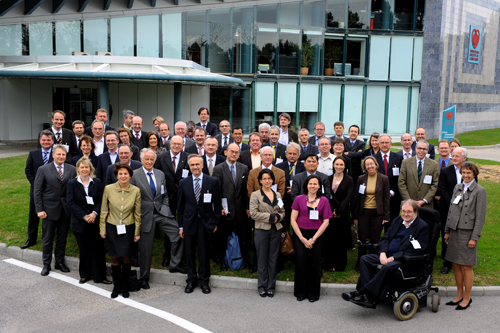Stroke Prevention, Thromboembolic Risk Assessment, Modification of Risk Factors, and Rhythm Control to Reduce Cardiovascular Complications in Atrial Fibrillation
8. - 9. November 2010, European Heart House, Sophia Antipolis, Frankreich
Wissenschaftliche Leitung
Günter Breithardt (Münster, Deutschland)
John Camm (London, UK)
Paulus Kirchhof (Birmingham, UK / Münster, Deutschland)
Gregory Lip (Birmingham, UK)

Group picture taken during the conference
60 eingeladene Vorhofflimmerspezialisten aus Wissenschaft und Industrie nahmen an der 3. AFNET / EHRA Konsensuskonferenz teil. Zusätzlich zu den Wissenschaftlern aus 14 europäischen Ländern waren auch einige ausgewählte Spezialisten aus Amerika dabei. Die Industrieteilnehmer kamen von AGA, Astra Zeneca, Bayer, Boehringer Ingelheim, Bristol-Myers Squibb, Daiichi Sankyo, Medtronic, MSD, Pfizer, Sanofi Aventis, and St. Jude Medical.
Die zweitägige Expertentagung startete mit einer Plenarsitzung. Anschließend wurden in sieben Kleingruppen verschiedene Themenkomplexe diskutiert und die Ergebnisse dieser Workshops anschließend wieder im Plenum vorgestellt. Auf diese Weise konnten die Experten ihr Wissen bündeln und Empfehlungen folmulieren.
Vortragsprogramm
- Outcomes in AF – what have we achieved, what can we do better? (J Camm, London, UK)
- Who is really at risk for stroke: A critical look at the 2010 ESC guidelines (E Hylek, Boston, USA)
- Bleeding risk with thromboprophylaxis? Who is at risk? (G Lip, Birmingham, UK)
- Mechanisms of intracerebral bleeding – what is known, what should be considered? (HC Diener, Essen, Germany)
- What can new antithrombotic compounds deliver in clinical practice (Dabigatran, Rivaroxaban, Apixaban)? (M Ezekowitz, Wynnewood, USA)
- AF is a risk factor for cardiovascular outcomes – insights from registries and trials. (P Dorian, Toronto, Canada)
- Can image-based assessment of the “AF substrate” help to guide therapy: MRI (scar imaging), echo (volumes), ECG parameters (L Mont, Barcelona, Spain)
- Different types of AF: Should they impact management? (P Kirchhof, Münster, Germany)
- Do we need novel rate control agents? How should therapy be titrated (resting heart rate, exercise-induced HR changes)? (I van Gelder, Groningen, The Netherlands)
- New devices for the diagnosis and therapy of AF. (P Vardas, Heraklion, Greece)
- Future targets for AF ablation – safety first? (S Willems, Hamburg, Germany)
- Novel antiarrhythmic drugs: What can we expect? (G Breithardt, Münster, Germany
- Patient values and preferences – insights from anticoagulation therapy and antiarrhythmic drug studies. (D Lane, Birmingham, UK)
Workshop-Themen
- Impact of patient education, patient values, and preferences on AF management
- Stroke and bleeding risk in AF revisited
- Novel risk factors for AF and AF-related complications (thyroid function, proteinuria, renal dysfunction)
- Comprehensive stroke risk reduction – a road to improving outcomes in AF (rhythm, blood pressure, post-stroke therapy)
- Devices to diagnose and treat AF and interactions of AF with device therapy
- AF is a risk marker – implications for general cardiovascular medicine
- Proposal for AF types that may require specific management
Publikationen
- Kirchhof P et al.: Comprehensive risk reduction in patients with atrial fibrillation: Emerging diagnostic and therapeutic options – a report from the 3rd Atrial Fibrillation Competence NETwork/European Heart Rhythm Association consensus conference. Europace. 2012; 14: 8-27.
- Kirchhof P et al.: Comprehensive risk reduction in patients with atrial fibrillation: Emerging diagnostic and therapeutic options. Executive summary of the report from the 3rd AFNET/EHRA consensus conference. Thromb Haemost. 2011; 106/6: 993-1234.
